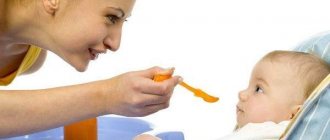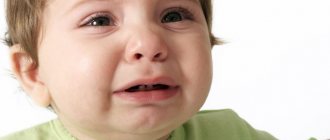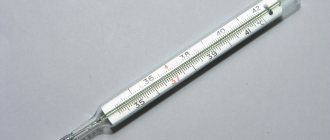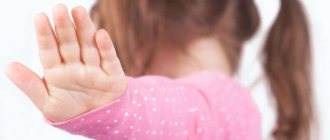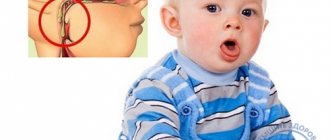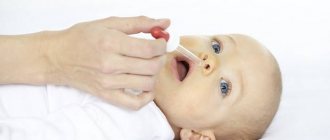Why does a cough occur when you have a runny nose?
A cough that accompanies a runny nose occurs due to the following reasons:
- Dry cough - due to irritation of the mucous membranes. If the symptom does not go away for a long time, this may indicate an allergic origin of rhinitis. The cough does not come from the bronchi or lungs, but from the larynx, the mucous membrane of which is greatly irritated upon contact with the allergen.
- Wet cough with rhinitis - mainly during sleep. The cause of the appearance is associated with mucus flowing down the back wall of the larynx from the nose. The body gets rid of the irritant through a respiratory response.
Medical diagnosis
Using a phonendoscope, the therapist will determine the nature of the cough and the path of mucus, and will also analyze other symptoms of which there are complaints, and then prescribe the appropriate treatment.
In most cases, experts recommend first treating a runny nose: rinsing the nose correctly and regularly so that the mucus comes out and does not fall into the respiratory tract.
In order to properly rinse a child’s nose, it is necessary to remember that mucus can be both thick and liquid, and different approaches must be taken to these manifestations of a runny nose:
- if the mucus is thick , it is necessary to make it liquid by inhaling with warm or cold steam and moistening the surrounding area. Also, various saline solutions or special sprays and drops for children are helpful for this purpose;
- if the mucus is liquid , all that remains for you is to properly rinse the child’s nose to free the nasopharynx from all irritating factors and prevent mucus from entering the lungs.
Dry cough with runny nose and fever
Any type of rhinitis can be accompanied by an increase in body temperature and a dry cough:
- Catarrhal rhinitis has a moderate clinical picture: breathing is difficult, a person breathes mainly through the mouth, which causes the laryngeal mucosa to dry out. A dry cough occurs.
- Allergic rhinitis is accompanied by fever when allergens have accumulated in the body, for example, due to constant contact with an irritant. Because of this, coughing attacks may also appear.
- With posterior rhinitis, which occurs against the background of viral and infectious diseases, a sluggish inflammatory process remains on the posterior wall. It causes fever, sore throat, and dry cough syndrome.
- In vasomotor rhinitis, the cause of fever is intoxication of the body by by-products of pathogenic microflora. A dry paroxysmal cough is a sign of irritation of the mucous membranes. But if the symptom changes its character and becomes moist, this may be a sign that pathogenic bacteria are moving lower through the respiratory system, affecting the bronchi or lungs.
How to treat a cough caused by a runny nose? Why is this happening and what to do?
A cough with a runny nose is a symptom of a disease caused by an infection spreading from the ENT organs to the respiratory system, irritation of the mucous membranes by mucus draining from the nose, or allergic reactions.
Why does a cough occur when you have a runny nose?
A cough that accompanies a runny nose occurs due to the following reasons:
- Dry cough - due to irritation of the mucous membranes. If the symptom does not go away for a long time, this may indicate an allergic origin of rhinitis. The cough does not come from the bronchi or lungs, but from the larynx, the mucous membrane of which is greatly irritated upon contact with the allergen.
- Wet cough with rhinitis - mainly during sleep. The cause of the appearance is associated with mucus flowing down the back wall of the larynx from the nose. The body gets rid of the irritant through a respiratory response.
With rhinitis, the appearance of a cough may be associated with the development of diseases such as tracheitis, laryngitis or pharyngitis. In all cases, it is only a concomitant symptom, so treatment is aimed at eliminating the root cause.
Dry cough with runny nose and fever
Any type of rhinitis can be accompanied by an increase in body temperature and a dry cough:
- Catarrhal rhinitis has a moderate clinical picture: breathing is difficult, a person breathes mainly through the mouth, which causes the laryngeal mucosa to dry out. A dry cough occurs.
- Allergic rhinitis is accompanied by fever when allergens have accumulated in the body, for example, due to constant contact with an irritant. Because of this, coughing attacks may also appear.
- With posterior rhinitis, which occurs against the background of viral and infectious diseases, a sluggish inflammatory process remains on the posterior wall. It causes fever, sore throat, and dry cough syndrome.
- In vasomotor rhinitis, the cause of fever is intoxication of the body by by-products of pathogenic microflora. A dry paroxysmal cough is a sign of irritation of the mucous membranes. But if the symptom changes its character and becomes moist, this may be a sign that pathogenic bacteria are moving lower through the respiratory system, affecting the bronchi or lungs.
Runny nose and cough during pregnancy
A pregnant woman's body experiences hormonal changes, which often results in coughing and runny nose. This may also be due to a depressed immune system, making the woman susceptible to viruses and infections.
Often during pregnancy, due to altered hormonal levels, allergic reactions develop, accompanied by dry mucous membranes, sore throat, coughing and discharge of mucus from the sinuses.
Cough from a runny nose in a child
In children, these signs may indicate infectious diseases of the upper respiratory tract. A dry cough often occurs as a result of the development of a number of pathologies: pharyngitis, tracheitis or laryngitis.
With a runny nose in children, loose mucus drips down the back of the throat. And if adults, even during sleep, can control this process by swallowing mucus, children cannot do this, so a cough occurs due to throat irritation.
In very young children, rhinitis with cough is often a reaction to teething. The child’s throat feels sore, causing him to start coughing.
In addition, such symptoms occur without any disease due to the fact that the air in the room is too dry.
The mucous membranes dry out, the body activates a protective reaction, trying to replenish the lack of moisture, and this is how discharge appears from the sinuses.
Treatment regimens
Treatment of cough with rhinitis is selected individually and consists of eliminating the root cause.
In dry air
Lack of moisture in the air is one of the main causes of cough and runny nose. If the humidity is not normalized, the situation will repeat itself constantly. No treatment is required as such, the main thing is to eliminate the cause. For this purpose, you can place containers of water in the room, hang wet towels, connect humidifiers, etc.
If breathing is severely congested due to the formation of crusts in the nose, they must be removed by first softening them with Vaseline or oil. You can quickly restore the condition and functioning of dry mucous membranes using inhalation. They are carried out using saline solutions; the salt concentration in the liquid should not exceed 0.9%. Such solutions can be used to rinse the nose.
During teething
First of all, you need to make sure that rhinitis with cough is caused by teething, and the child does not have infectious or viral diseases. To do this, you will need to contact your pediatrician. After confirming the diagnosis, the doctor will prescribe therapy.
To clear mucus from the sinuses, nasal solutions based on sea water are used:
- Aqua Maris;
- Marimer;
- Salin;
- Aqualor;
- Dolphin.
A runny nose can be cured with saline solution. Add 1 tsp to 1 liter of boiled water. sea or table salt. Take a small amount of liquid into a pipette and drop a few drops into each nostril. After a few minutes, remove mucus from the sinuses with an aspirator.
For allergies
The most effective way to get rid of allergic manifestations is to determine what is the irritating factor and limit contact with it. Depending on the intensity of the signs of allergic rhinitis, the following groups of medications can be prescribed:
- Antihistamines: Desloratadine, Cetrin. Medicines block the production of histamine, an increase in the concentration of which upon contact with an allergen is the cause of negative reactions in the body.
- Glucocorticosteroids (Nasonex). Drugs of this group for allergic type of runny nose are prescribed in advanced cases, when the reaction is intense, and antihistamines do not help.
- Leukotriene antagonists (Montelukast).
Treatment of the allergic form of rhinitis should only be prescribed by a doctor, since improper use of drugs, especially from the hormonal group, can lead to serious consequences.
To treat allergic cough and rhinitis, in addition to antihistamines, enterosorbents are used: activated carbon, Polysorb, Filtrum STI. Sorbents remove toxins and allergens from the body, reducing the intensity of allergic reactions.
For infectious diseases
Treatment of infectious diseases is complex. To quickly remove mucus from the sinuses and normalize breathing, drops and sprays are used:
- Vasoconstrictor action: Naphthyzin, Xylometazoline, Oxymetazoline.
- Softening and moisturizing effects: RinostopAqua, Aqualor Soft, Aqua Maris.
- Antiseptic: Miramistin, Rinostop.
If it is confirmed that rhinitis is caused by an infection, antibacterial drugs are prescribed. To treat a runny nose and prolonged cough, it is preferable to use drugs such as Co-trimoxazole and Amoxicillin.
Additional treatment methods include inhalation with antiseptic and antibacterial drugs. It is important to remember that inhalations can only be carried out in the absence of fever. If the temperature is elevated, antipyretic medications are used.
It is believed that one of the effective methods of treating rhinitis is a bath, but, as in the case of inhalations, if the temperature is elevated due to an infectious disease, you should not take a steam bath.
Cough preparations
Cough medications are selected by the doctor depending on the nature of the symptom:
- Mucolytics - thin the sputum, facilitating its easier removal: Trypsin, Ambroxol, Chymotrypsin, Bromhexine. Mucolytics are used for dry cough.
- Expectorants - promote the removal of phlegm: Thermopsis, Guaifenesin.
Inhalations with Decasan and Aminocaproic acid are good for getting rid of cough.
If the cough is of allergic origin, it is not treated. The symptom will go away on its own if you avoid contact with the allergen or after taking antihistamines.
Non-drug treatment
In addition to taking medications, when treating rhinitis accompanied by cough, it is recommended to carry out physiotherapeutic procedures:
- Laser therapy. The laser beam has a beneficial effect on blood vessels, which reduces swelling and inflammation and strengthens local immunity.
- UHF therapy. Aimed at reducing swelling and normalizing blood circulation in the sinuses.
- Use of ultraviolet light. It has a complex effect, relieves inflammation, reduces the amount of mucus, and destroys pathogenic microflora. The procedure helps to quickly ease nasal breathing.
Only the doctor decides which method of physiotherapy to choose.
Recommended traditional medicine methods:
- Aloe or beet juice. When fresh, the ingredients are passed through a meat grinder or finely chopped and squeezed through cheesecloth to separate the juice. The prepared product is instilled a few drops into each nostril several times a day.
- Rinsing the nose is a mandatory measure for the fastest treatment of rhinitis. The procedure uses saline solution.
- Vaseline with herbs. Apply a thin layer of self-prepared ointment to the inner walls of the nose. Pharmacy Vaseline is mixed with ground walnuts or crushed herbs: calendula, chamomile, St. John's wort.
- Drink made from honey with birch sap. Its regular use helps strengthen the immune system.
Physiotherapy and traditional medicine methods are allowed to be used only as an auxiliary treatment.
If rhinitis occurs frequently, including allergic rhinitis, one of the ways to treat and prevent recurrence is breathing exercises. The more often you perform it, the faster a positive result will be achieved.
Technique for performing breathing exercises:
- Sit on a chair, your back should be straight, but not tense.
- Place your index finger on the bridge of your nose, your thumb on the right side of your nose, and your middle finger on the left side.
- Taking a deep breath, close your left nostril tightly with your fingers. Wait 5 seconds, inhale and close the second nostril.
- Hold the air for 10 seconds, then release your thumb.
The number of approaches is at least 10. You need to repeat the gymnastics several times a day.
In addition to breathing exercises, it is useful to massage the sinuses. It helps improve blood circulation, strengthen local immunity and active cell regeneration. The massage consists of rubbing the bridge of the nose. It is recommended to carry out the procedure with essential oils. Eucalyptus oil is especially useful, as it has proven itself in the treatment of rhinitis.
Source: https://MyKashel.ru/lechenie/kashel-ot-nasmorka.html
Cough from a runny nose in a child
In children, these signs may indicate infectious diseases of the upper respiratory tract. A dry cough often occurs as a result of the development of a number of pathologies: pharyngitis, tracheitis or laryngitis.
With a runny nose in children, loose mucus drips down the back of the throat. And if adults, even during sleep, can control this process by swallowing mucus, children cannot do this, so a cough occurs due to throat irritation.
In very young children, rhinitis with cough is often a reaction to teething. The child’s throat feels sore, causing him to start coughing. In addition, such symptoms occur without any disease due to the fact that the air in the room is too dry. The mucous membranes dry out, the body activates a protective reaction, trying to replenish the lack of moisture, and this is how discharge appears from the sinuses.
Home inhalations
Inhalations will help complement the restorative effect. For the procedure with a nebulizer, ordinary mineral water without gas or Lazolvan are excellent. It is recommended to breathe fumes not only in the morning, but also in the evening.
If there is no special remedy for such procedures when a child coughs from snot, it is permissible to use a pan with hot contents. To do this, prepare decoctions of various herbs (sage, chamomile, calendula). The child's head is tilted over the hot liquid and covered with something dense: a blanket or towel. Such sessions should last no more than five to seven minutes.
Treatment regimens
Treatment of cough with rhinitis is selected individually and consists of eliminating the root cause.
In dry air
Lack of moisture in the air is one of the main causes of cough and runny nose. If the humidity is not normalized, the situation will repeat itself constantly. No treatment is required as such, the main thing is to eliminate the cause. For this purpose, you can place containers of water in the room, hang wet towels, connect humidifiers, etc.
If breathing is severely congested due to the formation of crusts in the nose, they must be removed by first softening them with Vaseline or oil. You can quickly restore the condition and functioning of dry mucous membranes using inhalation. They are carried out using saline solutions; the salt concentration in the liquid should not exceed 0.9%. Such solutions can be used to rinse the nose.
During teething
First of all, you need to make sure that rhinitis with cough is caused by teething, and the child does not have infectious or viral diseases. To do this, you will need to contact your pediatrician. After confirming the diagnosis, the doctor will prescribe therapy.
To clear mucus from the sinuses, nasal solutions based on sea water are used:
- Aqua Maris;
- Marimer;
- Salin;
- Aqualor;
- Dolphin.
A runny nose can be cured with saline solution. Add 1 tsp to 1 liter of boiled water. sea or table salt. Take a small amount of liquid into a pipette and drop a few drops into each nostril. After a few minutes, remove mucus from the sinuses with an aspirator.
For allergies
The most effective way to get rid of allergic manifestations is to determine what is the irritating factor and limit contact with it. Depending on the intensity of the signs of allergic rhinitis, the following groups of medications can be prescribed:
- Antihistamines: Desloratadine, Cetrin. Medicines block the production of histamine, an increase in the concentration of which upon contact with an allergen is the cause of negative reactions in the body.
- Glucocorticosteroids (Nasonex). Drugs of this group for allergic type of runny nose are prescribed in advanced cases, when the reaction is intense, and antihistamines do not help.
- Leukotriene antagonists (Montelukast).
Diseases that cause coughing from snot
Excessive mucus production in the nasal cavity is caused by several diseases. Among which are the following:
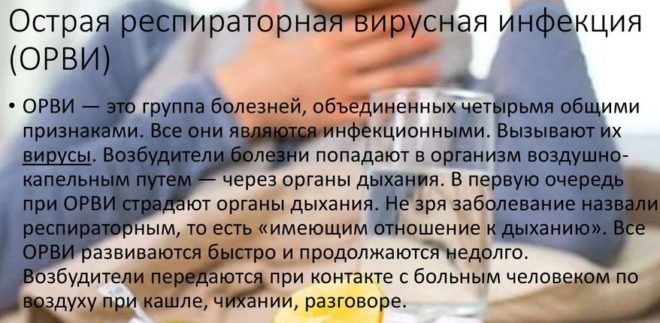
ARVI causes cough from snot
- sinusitis (sinusitis, sinusitis, etc.);
- ARVI (acute respiratory viral infections);
- rhinitis (inflammation of the nasal mucosa of various etiologies).
Of course, these diseases require an individual approach to treatment. It is important to differentiate and understand how these diseases differ. Sinusitis of any etiology, in addition to a severe runny nose, will be accompanied by pain on the face in the projection of the location of the bone cavities in which the pathological process develops. Such projections are located in the forehead, cheeks or nose.
The development of an acute respiratory viral infection will be accompanied by an increase in the child’s body temperature, weakness, lethargy and the release of clear snot.
If these symptoms (pain in the projection of bone cavities, fever) are not observed in the child, the cause is inflammation of the mucous membrane. It is necessary to determine what origin of rhinitis caused the excessive discharge of snot. Rhinitis of any etiology (allergic, hypertrophic, catarrhal) should have individual therapy.
The appearance of dry and wet cough
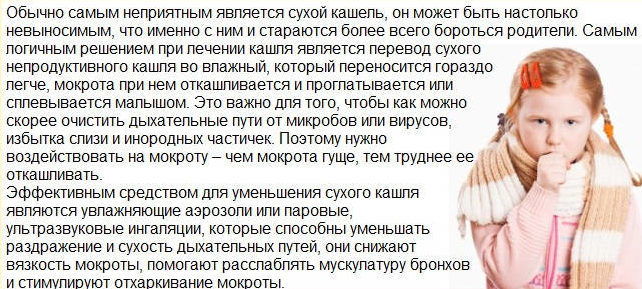
Dry cough due to snot
When snot is caused by an infection, there is a risk of germs spreading down the respiratory tract. Mucus contains a large number of substances that have an antibacterial effect, and normally they neutralize the infectious agent. But a small percentage of living pathogenic organisms remains in the mucus, which can flow down the nasopharynx, larynx, etc. A dry cough occurs when there is not a lot of snot and the cough receptors react well, the child will cough up the mucus and spit it out. In this case, you need to teach your baby to blow his snot correctly. Medications can be used to remove mucus. Moisturizing the mucous membrane of the nasal passages using various saline solutions will be very effective for dry cough.
A wet cough occurs when mucus constantly drains from the nasopharynx into the trachea and is expelled when coughing.
The development of a wet cough occurs when mucus constantly drains from the nasopharynx into the trachea and is expelled when coughing. This happens if the snot has a very liquid consistency, reminiscent of water. This is a dangerous condition, because the respiratory system can suffer from an excess of foreign biological fluid. There is a possibility of developing a secondary inflammatory process in the bronchial tree.
If a child develops a wet cough against the background of snot, which has a thick consistency, then there is a high probability that the baby has a cold and the disease develops in the lower parts of the respiratory system. In this case, parents need to pay special attention to the treatment of pulmonary disease in the child in order to prevent the development of severe pulmonary complications.
Cough preparations
Cough medications are selected by the doctor depending on the nature of the symptom:
- Mucolytics - thin the sputum, facilitating its easier removal: Trypsin, Ambroxol, Chymotrypsin, Bromhexine. Mucolytics are used for dry cough.
- Expectorants - promote the removal of phlegm: Thermopsis, Guaifenesin.
Inhalations with Decasan and Aminocaproic acid are good for getting rid of cough.
If the cough is of allergic origin, it is not treated. The symptom will go away on its own if you avoid contact with the allergen or after taking antihistamines.
Cough from snot in a child at night: treatment depending on age and popular drugs
Cough from snot in a child at night requires early treatment, due to the high risk of developing pneumonia. Coughing is a physiological reaction aimed at clearing the lumen of the bronchi and trachea from mucus, however, with excess accumulation, the cough turns into attacks that disturb the child’s night sleep.
With severe allergies, swelling of the nasopharynx and allergic rhinosinusitis, excessive formation of exudate leads to a cough in the morning. The risk of developing bacterial bronchitis as a result of bacterial invasion increases, especially in younger children. Treatment depending on age is based on the physiological characteristics of the child’s body. Newborns and infants are advised to change the properties of air, use humidifiers and ionizers that moisturize the mucous membrane and prevent the formation of crusts and mucus.
Children after two years of age are recommended to rinse their nose with sea salt solutions, which you can buy at the pharmacy or prepare yourself. For severe runny nose, vasoconstrictor drops are used to eliminate swelling of the mucous membrane. Drugs aimed at eliminating viral or bacterial infections are more often used in children over 5 years of age. The choice of medication is made by the attending physician after examination and identification of the etiological factor. For allergies, antihistamines are prescribed to relieve swelling and block the production of exudate.
Vasoconstrictor drops are used only after the recommendation of a pediatrician, in the dosage prescribed for a specific age. The drops begin to act 15 minutes after instillation, the duration is from 3 to 5 hours. For children under 6 years of age, the use of drops rather than sprays is recommended due to the risk of the jet entering the mouth of the Eustachian tube and damaging the mucous membrane. Rinse solutions are actively used starting from the age of 2 years of a child’s life. For colds and flu, wash the nose 3 to 4 times a day for a week.
Rinsing removes bacteria and viruses from the nose and prevents pathogens from entering the lower respiratory tract. Antiseptics are used in children over 12 years of age, due to their strong effect on the mucous membrane. The drugs are aimed at local destruction of pathogenic flora at the site of inflammation, and are extremely effective when prescribed together with antibiotics or antiviral agents. Inhalation of active substances and essential oils has a protective effect on the bronchi, restoring the mucous membrane, and an expectorant effect and sputum production. Inhalations reduce nasal congestion, make breathing more free, and relieve inflammatory changes in the nasopharynx.
Prevention
Prevention of cough from snot is aimed at preventing mucous contents from entering the laryngeal cavity. In order to avoid having to treat a cough from snot in a small child in the future, you need to:
- use vasoconstrictor drops for severe congestion;
- Rinse your nose regularly with saline solution;
- use an aspirator for a runny nose in children of the first year of life;
- during sleep, place the child on a pillow so that mucus does not drain into the bronchi;
- take expectorant syrups for children over 5 years of age.
